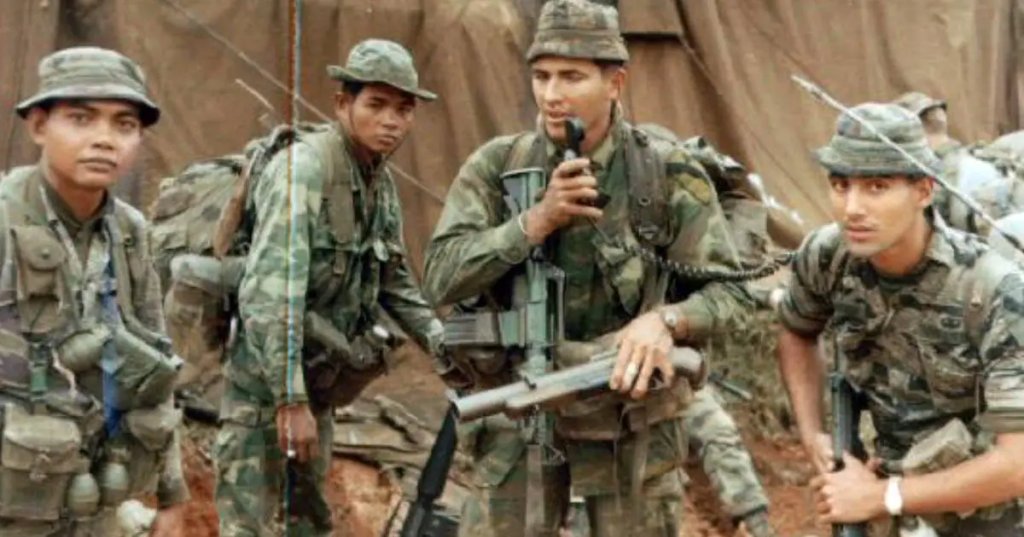

When Maj. Gen. William Westmoreland took command of the 101st Airborne in 1958, he noticed a severe lack of proficiency in small-unit tactics and patrolling. So he immediately created a school to fix the problem. When he took command of all American forces in the Vietnam War, he once again created a school to teach long-range patrolling and small unit tactics with a Ranger-qualified cadre of instructors from the 5th Special Forces Group. To graduate from this school, you had to bet your life on it.
Dubbed “Recondo” school, Westmoreland claimed it was an amalgamation of Reconnaissance, Commando and Doughboy. Recondo training emphasized both reconnaissance and standard infantry skills at the small unit level.
In 1960, Army Magazine described the Recondo tactics as “dedicated to the domination of certain areas of the battlefield by small aggressive roving patrols of opportunity which have not been assigned a definite reconnaissance or combat mission.” From these graduates, the 101st developed the Recondo Patrol.
This patrol type was meant to allow a Recondo to create as much havoc as possible in their area of operations. The patrol could be used against a disorganized enemy, as a screen for retrograde operations, to develop a situation or conduct a feint ahead of an advancing force, or to eliminate guerrilla activity.
It was the last ability that Recondos would put to great use in Vietnam.
The Recondo school was set up at Nha Trang and was inspired but the highly successful Long-Range Reconnaissance Patrol training conducted by detachment B-52 from 5th Special Forces. This program, known as Project Delta, was originally intended to train Special Forces and their Vietnamese counterparts in guerrilla-like ambushes.
The course became so popular that within two years over half of the students were from regular Army units. Westmoreland expanded the school to teach Recondo tactics to as many LRRPs as possible.

COMPANY ASSOCIATION
In order to qualify for the MACV Recondo school, participants had to be in-country at least one month and have at least six months remaining on their tour upon completion. Students also had to have a combat arms MOS and an actual or pending assignment to an LRRP unit. Finally, they had to be in excellent physical shape and be proficient in general military knowledge.
The school was open to soldiers and marines of the Free World Military Assistance Forces, including the South Vietnamese, Koreans, Australians, and Filipinos. Many U.S. Marines also attended the training.
The curriculum of the school included improving students’ skills in the areas of map reading, intelligence gathering, weapons training, and communications. Weapons training included a variety of American weapons as well as weapons used by the Viet Cong and North Vietnamese army. Particular attention was also given to mines and booby-traps. Communications covered the use of several different radios, field expedient antennas, and proper message writing techniques.

The school also gave advanced training in medical treatment, including the use of Ringer’s lactate solution and intravenous and intramuscular injections. Schooling also focused on air operations – especially the use of the UH-1 Huey helicopter for insertions and extractions. Forward Air Controller techniques were taught with students calling in live ordnance on a target.
Most importantly, the school taught patrolling.
Students learned different patrolling techniques, preparation, and organization. Proper patrol security was taught along with intelligence-gathering techniques. The students trained heavily in immediate action drills to react to or initiate enemy contact.
After over 300 hours of training, averaging over 12 hours per day, it was time for the students to take the final exam: an actual combat patrol.
In the early days of the program, the area the prospective graduates patrolled was relatively secure and quiet. As the war progressed, however, contact with the enemy became a given. This led to students saying “you bet your life” to graduate from Recondo School.
At least two students died in Recondo training with many others wounded. An unknown number of Viet Cong were also killed in the skirmishes during the “you bet your life” patrol. This led to the school itself receiving a nickname of its own: “the deadliest school on earth”.
In just over four years of operation, over 5,600 students attended Recondo school. Just 3,515 men graduated, not quite two-thirds of all who tried. Each student who graduated was awarded a Recondo patch, worn on the right breast pocket, and an individual Recondo number that was recorded in their 201 personnel file. The Honor Graduate from each class was also given a specially engraved Recondo knife.

COMPANY ASSOCIATION
Despite the school and its graduates’ success, Westmoreland’s successor, Gen. Creighton Abrams, officially closed the school on December 19, 1970. The Recondo name and training lived on, as some divisions continued to host their own Recondo schools until they were eventually closed too.
